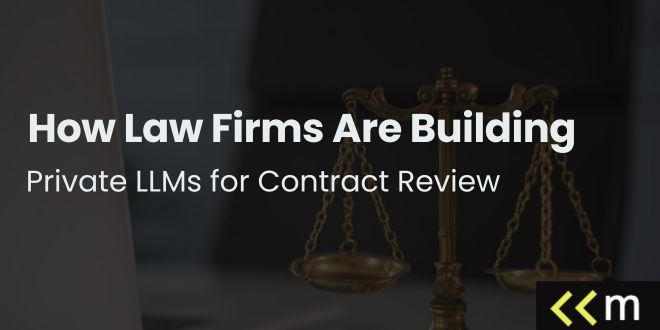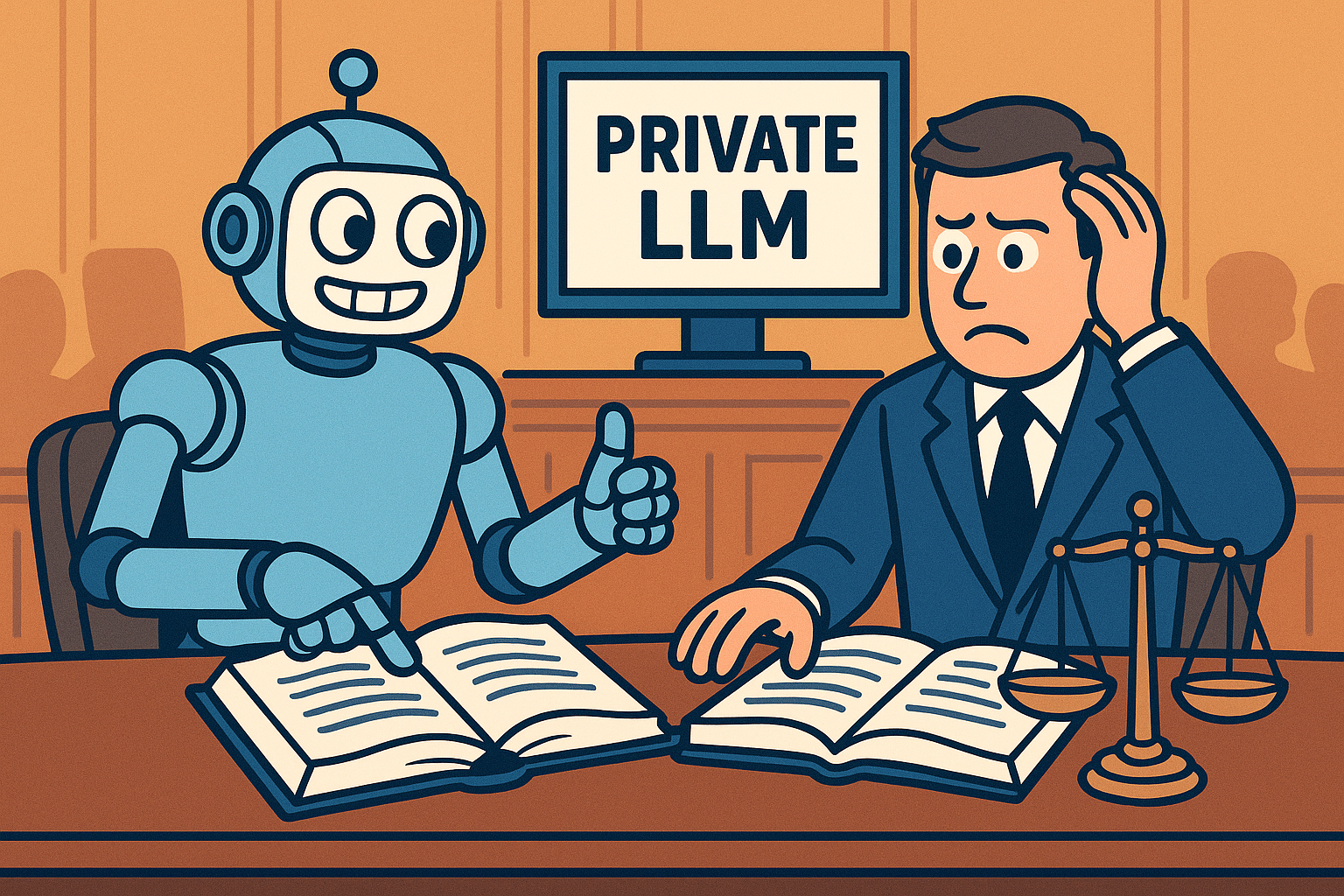How Law Firms Are Building Private LLMs for Contract Review

Contract review is a perfect storm of repetition, nuance, and time pressure. No wonder firms are exploring private systems built around a Large Language Model for law firms to speed up the slog without losing the nuance.
The goal of private AI is simple to say and tricky to do.
Build an assistant that can read, reason, and suggest edits like a seasoned associate, while keeping client data sealed tight and satisfying the firm’s appetite for control.
The twist is that success depends less on flashy model names and more on careful engineering, governance, and a work culture that welcomes an AI colleague without giving it the keys to the entire filing room.
Why Firms Choose Private Models Over Public Services
Public AI services are convenient, yet they raise questions about data residency, confidentiality, and consistent output. A private model lets a firm lock down sensitive language, tune behavior to house style, and align the system with its risk tolerance. It can be deployed on infrastructure the firm trusts, inspected by the security team, and integrated with document management without a parade of extra approvals.
The result is a tool that fits the firm rather than forcing the firm to fit the tool. There is also the matter of predictable performance. A private model can be pinned to specific versions, tested against the firm’s benchmarks, and updated on a cadence that suits clients and regulators. That stability matters when redlines decide dollars and obligations.
The Data Pipeline That Feeds the Model

Sourcing and Cleaning Contracts
Every great model is built on dependable data. Firms often start with a carefully curated library of templates, playbooks, and prior work product cleared for internal use. These documents are standardized, scrubbed of client identifiers, and mapped to a taxonomy that reflects the firm’s practice groups. Clauses are labeled by function and risk posture. Definitions are normalized so that “Confidential Information” in one template matches the concept used elsewhere.
This is the legal equivalent of sharpening knives before cooking. Cleaning is not glamorous, yet it is mission critical. Optical character recognition is fixed, tables are reconstructed, and awkward scanning artifacts are retired. The pipeline keeps versions, captures provenance, and tags each artifact with metadata such as governing law, industry, and contract type. With that done, the model can learn without swallowing grit.
Annotation That Lawyers Actually Trust
Annotation separates responsible AI from wishful thinking. Subject-matter experts annotate clauses with rationales, not just labels. They mark what is acceptable, what is negotiable, and what triggers escalation. Comments include short explanations a junior could understand.
When lawyers see their logic reflected in training data and prompts, they trust the system more. The payoff appears later when the model explains a suggested change in plain language that actually sounds like the firm.
Architecture Choices Behind the Curtain
Retrieval-Augmented Generation Over Plain Generation
Contract law rewards accuracy. Firms lean on retrieval-augmented generation (AKA RAG) so the model cites approved clauses and guidance instead of inventing them. A vector index holds canonical language, fallback options, and internal commentary.
At query time, the legal AI system retrieves relevant passages, then asks the model to reason with those passages in view. The output is grounded and therefore auditable. If a suggestion misfires, the team can trace it back to sources and fix the pipeline, not just scold the model.
Model Size and Hosting Options
Bigger is not always better. Mid-sized models that are fine-tuned on the firm’s domain often hit a sweet spot of accuracy, latency, and cost.
Hosting happens in environments the law firm controls, which might be on-premises clusters or a virtual private cloud. Hardware choices balance bursty workloads with predictable deadlines. The technology stack is less about hype and more about keeping review time low and output stable.
Security, Privacy, and Risk Controls
Confidentiality is contractual, ethical, and personal.
Private deployments use strong access controls tied to identity and role.
Documents are encrypted at rest and in transit. Inference requests are logged with enough detail for auditing, without leaking sensitive text. Sensitive outputs can be masked until a human approves them.
Redaction tools run before data ever touches the training pipeline, and the pipeline preserves a chain of custody.
Firms also constrain what the model is allowed to do. If a clause falls outside policy, the system defers to a human rather than guessing. That refusal can be a feature. It prevents the model from happily marching into novel territory without a guide.
Training and Fine-Tuning Strategies That Work
Synthetic Data With Guardrails
To augment scarce annotations, teams generate synthetic examples from their own playbooks. The trick is restraint. Synthetic data is created under strict prompts and reviewed by attorneys, or it never sees the training set. Bad synthetic data teaches bad habits. Good synthetic data fleshes out edge cases, so the model learns to handle both friendly NDAs and thorny licensing terms with equal calm.
Domain Adaptation Over Full Fine-Tuning
Full fine-tuning can be expensive and brittle. Many firms prefer domain adaptation with techniques that steer the model rather than overhaul it. System prompts encode the house style. Adapters or lightweight fine-tuning capture specialized phrasing. The result is a model that behaves like a well-briefed associate rather than a brand-new hire learning every habit from scratch.
Evaluation and Quality Assurance
Accuracy Beyond Redlines
Redlines are only the beginning. Evaluation considers whether the model spotted landmines, justified its advice, and respected the firm’s risk posture. Benchmarks include clause classification, risk scoring, fallback selection, and rationale quality. Tests are run on a holdout set the model never saw. Scores are tracked over time like a fitness plan, with regression alerts when an update accidentally teaches the model a bad trick.
Adversarial Tests and Edge Cases
Contracts are full of gotchas. The system is tested with adversarial examples that flip meanings with a tiny tweak. Nested definitions are checked. Cross-references are verified. Units and thresholds are scrutinized. These tests catch brittle behavior early and force the model to read like a lawyer, not a pattern-matching parrot. When the model flags uncertainty, that is recorded as a success, not a failure, because it routed the problem to a human.
Deployment and Workflow Integration
Human-in-the-Loop by Design
Private models do not replace attorneys. They accelerate them. The system highlights clauses, proposes alternatives, and explains tradeoffs in context. A reviewer can accept, edit, or reject with a click. Comments flow back into the training pipeline as feedback. The human stays in charge, which makes clients comfortable and keeps errors from escaping into the wild.
Explainability and Audit Trails
Every suggestion carries a breadcrumb trail that shows sources, reasoning steps, and confidence. This is priceless during partner review and risk audits. When an associate asks why the model pushed for a mutual confidentiality clause, the system points to the firm’s policy and the governing law in the template, not a mysterious vibe. That clarity earns trust faster than any marketing slide.
Governance and Ethics
Governance gives shape to the whole effort. A cross-functional council of partners, technologists, knowledge managers, and security leads sets policy. They decide which use cases are in scope, what error rates are acceptable, and how to sunset old behaviors. Model updates follow a change-control process. The system is monitored for bias, leaking, and drift. If a new regulation arrives, the council can react with a clear path that does not rely on heroics.
Ethics is the quiet backbone. The model is transparent about what it can and cannot do. Client consent is obtained where needed. Credit for the work product remains with the humans who supervise the output. The system aims to raise the floor for quality while freeing lawyers to handle strategy, negotiation, and client care.
Cost, Performance, and ROI Reality Check
Private LLM costs split across compute, storage, annotation, and maintenance. The spend is justified by cycle time saved, accuracy improved, and happier clients. A realistic plan ties model performance to contract types and practice areas with clear service levels. Latency targets matter. Reviewers will not wait five minutes for a clause suggestion while a deal clock ticks. Caching, smart retrieval, and pragmatic model sizes keep interactions snappy.
There is also cultural ROI. Associates spend less time hunting for the right clause and more time learning why a clause belongs there. Partners can enforce consistent standards across teams. Business development benefits when the firm can promise faster turnarounds without cutting corners. It is hard to overstate how much that steadiness matters to clients who live by deadlines.
Conclusion
Private contract-review models succeed when firms treat them like long-term teammates, not novelty gadgets. The work is practical. Curate clean data, encode policy in prompts and retrieval, test like a skeptic, and keep a human in charge. Protect client information with real controls, not optimistic hopes.
Choose architectures that favor reliability over flash. If the result feels like a well-trained associate who never gets tired, you built the right thing. If it feels like a magic trick, keep going until the trick becomes a trustworthy habit.
Eric Lamanna is VP of Business Development at LLM.co, where he drives client acquisition, enterprise integrations, and partner growth. With a background as a Digital Product Manager, he blends expertise in AI, automation, and cybersecurity with a proven ability to scale digital products and align technical innovation with business strategy. Eric excels at identifying market opportunities, crafting go-to-market strategies, and bridging cross-functional teams to position LLM.co as a leader in AI-powered enterprise solutions.







